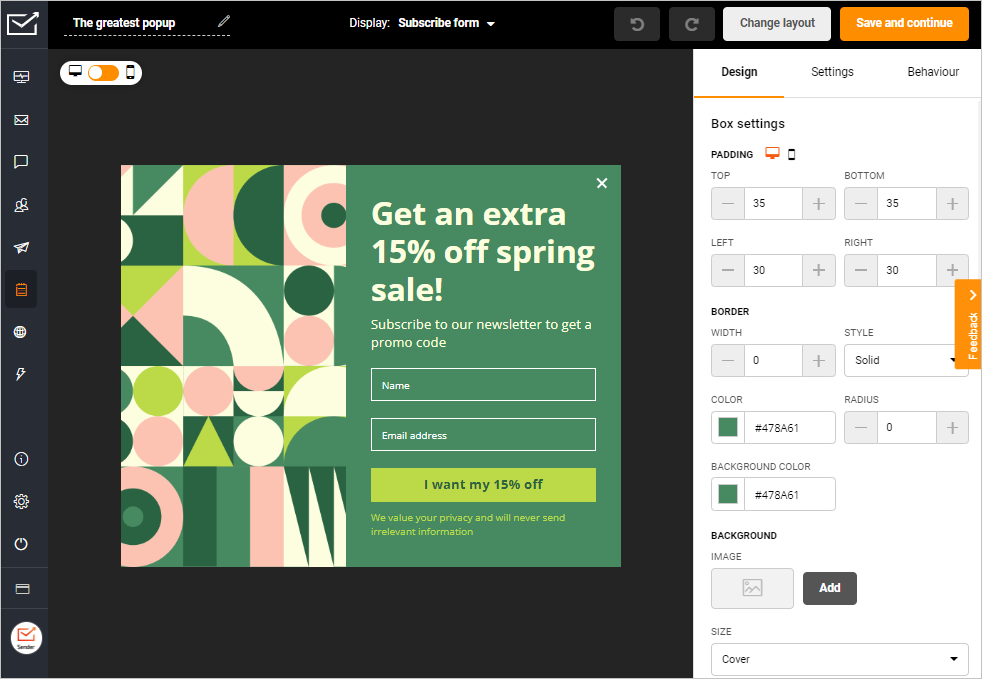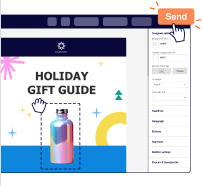Chasing more leads doesn’t always mean closing more deals. What actually moves the needle is knowing which leads are worth your time. That’s where lead scoring comes in.
By assigning scores based on behavior, intent data, and fit, you can build a system that helps your sales team focus on the most promising prospects. Plus, it saves you a lot of time and effort wasted otherwise.
In this guide, we’ll share some lead scoring basics, show how to build a scoring model, and best practices we’ve tested to help you improve conversion rates without increasing effort.
So, let’s begin.
What is Lead Scoring?
Scoring leads involves assigning a numerical value or score to individual leads, indicating their likelihood of converting into a customer, making lead scoring important for businesses.
Think of it as a simple system of assigning points to all your leads, let’s say, on a scale of 0 to 100. The closer a lead is to 100 (high score), the higher the likelihood of conversion.
The lead scores depend on different attributes or behaviors of a lead, like clicking a button, checking the pricing page, engagement behavior, or online activity. For example, a lead who has signed up for a free trial will have a higher lead score than someone who has just signed up for your newsletter.
Lead scoring helps optimize lead generation and marketing efforts by helping identify and prioritize leads with the highest potential for conversion.
Explicit Lead Scoring
Explicit lead scoring involves collecting information directly provided by the leads themselves, usually through signup forms or surveys. This information includes demographic data, job titles, company size, purchase intent, and other relevant details. Here are a few attributes used to score leads explicitly:
- Demographic information. Age, gender, location, industry, company size, etc.
- Job title and role. Decision-making positions, specific departments, management levels;
- Firmographics. Company revenue, annual budget, years in operation;
- Purchase intent. Timeframe for purchase, budget availability, and specific requirements;
- Form responses. Specific questions answered, level of detail provided;
- Interaction history. Previous purchases, webinar attendance, and event registrations.
The explicit data is used to assign scores to leads based on predefined criteria set by the marketing team. For example, imagine a B2B company that sells marketing automation software. They may consider leads from enterprise-level companies with specific job titles, such as marketing managers or directors, as more valuable. In their lead scoring algorithm, the scoring criteria assign higher scores to leads that match these attributes.
By gathering explicit information through forms or surveys, they can identify leads that meet their ideal customer profile and prioritize them for targeted sales outreach or tailored marketing campaigns.
Implicit Lead Scoring
Implicit lead scoring involves gathering data and analyzing a prospect’s online activity or behavior during their interactions. These ‘implied’ actions are typically tracked using marketing automation tools, heatmaps, or web analytics platforms. Here are some of the implicit attributes to track:
- Website behavior. Number of page visits, time spent on the website, specific pages viewed;
- Content engagement. Whitepapers, case studies, eBooks download or watching videos;
- Email engagement. Email opens, click-through rates, interactions with links or attachments;
- Social media activity. Likes, comments, shares, mentions, followership;
- Online advertising response. Clicks on ads, engagement on ad campaigns;
- Customer support interactions. Live chat conversations and support ticket submissions.
Evaluating implicit signals like website visits, content downloads, email opens, clicks, and social media engagements help businesses assign a lead score based on their level of engagement and interest.
Take the example of a software company that offers a free trial. A trial customer frequently uses different features, and raising support tickets suggests a higher likelihood of converting to a paid customer. The implicit behavior makes them a priority for the marketing team to target using personalized nurturing campaigns or incentives to accelerate conversion further.
How Can You Determine a Basic Lead Score?
If you’re new to lead scoring, start simple. You don’t need a complex mechanism at the beginning.
Find an easy way to rank leads based on who they are and how they engage with your brand.
Here’s a basic example of a lead scoring criteria using common data points:
Start by assigning points based on two types of data: fit and behavior.
- Fit includes firmographic or demographic data, like job title, industry, company size, or location. For example, you might give +10 points to a lead from your target industry, and subtract points if they fall outside your ideal customer profile;
- Behavior tracks engagement, like email opens, clicks, page visits, or downloads. Someone who visits your pricing page or opens multiple emails might get +20, while inactive leads get negative lead scoring.
Use a scoring system that adds or subtracts points based on these data points. Define your top 3–5 traits or actions that show buying intent, and build your first lead scoring framework around that. You can also use AI or machine learning tools these days to build something that suits your sales cycle.
Key Factors to Consider Before Using Lead Scoring Models
Before you start working with a lead scoring model, ensure you’ve got the fundamentals sorted. Lead scoring only works when your data, goals, and teams are aligned. Rushing into it without clarity can lead to missed opportunities or wasted sales efforts.
Here are some factors you should focus on:
- Getting clean & reliable data. Bad data ruins scores. Make sure your CRM data is accurate and updated regularly;
- Well-defined ideal customer profile (ICP). Scoring means nothing without clear buyer personas. Know who you’re targeting before ascertaining a criteria for lead scoring;
- Strong sales and marketing alignment. Both teams must agree on what a qualified lead looks like and work in sync through the entire buyer’s journey;
- Enough traffic and leads. Lead scoring only works when you have enough volume to track patterns. So, marketing should bring necessary traffic to your lead magnets;
- Clear scoring goals. Decide what you want to achieve beforehand. Do you need more conversions, shorter sales cycles, or something else?
What are Lead Scoring Models?
With so many benefits of scoring leads, you’d be eager to get your hands on some lead-scoring models to unearth the best leads from your database.
We’ve curated the best-performing lead-scoring models based on common knowledge and industry performance. Check these lead scoring models below and pick one that suits your business model:
Demographic Information
Demographic lead scoring involves giving scores based on personal information. This model focuses on demographic factors such as age, gender, location, job title, and industry to gauge the potential value and fit of a lead for the business. Some attributes and examples for demographic lead scoring include:
- Job title. Higher-level positions may indicate decision-making authority or influence;
- Industry. Leads from specific sectors may be more likely to convert due to their relevance to the product or service;
- Company size. Larger companies may have higher budgets and more significant potential for larger purchases;
- Geographic location. Targeting leads in specific regions can help tailor marketing efforts to their needs or preferences;
- Annual income. For B2C businesses, income levels can indicate purchasing power.
Company Information
This model evaluates the attributes and characteristics of a lead’s company to determine their potential value. It looks at factors such as company size, industry, revenue, and technographic data to assess the likelihood of a conversion. Here are some examples of attributes for company lead scoring:
- Company revenue. High-revenue companies may have greater budget availability for purchases;
- Industry fit. Leads in industries that align with the business’s target market are more likely to convert;
- Technographic data. Identifying if a company already uses relevant technologies or tools can indicate their need for the product;
- Growth rate. Fast-growing companies may have more significant demands and investment capabilities;
- Funding. Companies that recently secured funding or received investments may have additional resources.
Online Behavior
Using online behavior for lead scoring is an implicit tactic that involves tracking and analyzing the digital interactions across the website and landing pages. This model focuses on actions taken by leads, providing insights into their level of engagement and interest. Examples of attributes for online behavior lead scoring include:
- Website visits. Number of visits, time spent on the website, and specific pages viewed;
- Content engagement. Downloads such as whitepapers, eBooks, or case studies;
- Webinar attendance. Participation in live or on-demand webinars;
- Form submissions. Filling out contact forms or request forms;
- Search queries. Keywords or topics searched on the website.
Email Engagement
Lead scoring based on email engagement involves assessing how leads interact with marketing emails. Factors such as opens, clicks, and responses are critical to assign lead scores. Examples of attributes for email engagement lead scoring include:
- Email open rate. Tracking the frequency and consistency of a lead opening marketing emails;
- Click-through rates. Measuring the percentage of leads who click on links within emails;
- Conversion actions. Tracking specific actions taken, such as filling out a form or making a purchase, after clicking an email link;
- Unsubscribe rates. Monitoring leads who opt out of email communications;
- Email responses. Tracking leads who reply to emails or express direct interest.
Social Engagement
Scoring based on social media engagement is a great tactic to measure the stickiness and virality of your content. It involves evaluating a lead’s interactions and engagement on social media platforms, such as likes, comments, shares, and mentions. Higher the engagement, the higher the score. Examples of attributes for social engagement lead scoring include:
- Likes and shares. Tracking the number of likes and shares of a company’s social media posts;
- Comments and replies. Assessing the engagement level through comments or reactions to posts;
- Mentions and tags. Monitoring when a lead mentions or tags the company on social media;
- Follower count. Evaluating the number of followers a lead has, indicating their potential reach and influence.
Spam Detection
This involves evaluating leads to determine their likelihood of being spam or low-quality leads. This model helps ensure the scoring system focuses on genuine, high-quality leads.
- Disposable email addresses. Email addresses from temporary or disposable email providers indicate low-level of interest in a product or service;
- Suspicious or irrelevant form responses. Responses that may appear suspicious or irrelevant to the business should be given lower lead scores;
- IP address checks. The reputation and origin of the IP address associated with the lead should impact the lead score;
- Blacklist checks. Checking lead data against known spam email lists or databases.
Alignment Between Marketing and Sales
This lead scoring model evaluates the synchronization and fits between a lead’s real attributes and the ideal customer profile defined by the marketing teams. This model helps ensure that the pursued leads align with the business’s target market and sales goals.
Examples of attributes for alignment lead scoring include:
- Ideal customer profile fit. Evaluating how closely a lead matches the criteria set for the ideal customer;
- Sales and marketing interaction history. Assessing the level of engagement and collaboration between the lead and the marketing and sales teams;
- Lead qualification criteria. Determining if a lead meets the predefined qualification criteria the sales team sets;
- Sales feedback and ratings. Gathering feedback and ratings from the sales team on lead quality and fit;
- Opportunity stage. Evaluating the stage of the lead within the sales pipeline or funnel.
Lead Scoring Threshold
The lead scoring threshold is the prearranged score determining whether a lead is qualified. When a lead crosses the ‘threshold’ score, it’s passed from the marketing team to sales for sales enablement. This tactic helps establish a clear benchmark for lead qualification. Here’s how you can set up a lead-scoring threshold:
- Point-based scoring. Assigning a numerical value to each lead attribute and determining the threshold based on the accumulated score and past lead qualification history;
- Scoring tiers. Grouping leads into different categories or tiers based on their scores and defining the threshold for each tier;
- Qualification criteria. Setting specific requirements or conditions that a lead must meet to cross the scoring threshold;
- Historical conversion data. Analyzing historical data to determine the score range that has resulted in successful conversions;
- A/B testing. Experimenting with different scoring thresholds and measuring the impact on conversion rates to optimize the threshold value.
Lead Scoring Best Practices
The best lead scoring models use the right approaches to deliver results. Basically, they follow some best practices to avoid common mistakes and focus on things that actually improve lead quality.
Here are some proven lead scoring best practices you should implement:
Keep It Simple at First
As we’ve said before, there’s no need to overcomplicate your first lead scoring system.
Focus on 3–5 high-impact traits—like job roles, page visits, demo requests, or email engagement. These basic data points help you in prospect scoring without any overwhelm.
Avoid getting caught up in complex logic or predictive lead scoring models too soon.
Start simple, track performance, and gradually layer in more attributes once your scoring system starts showing results.
Stay Current With Your Data
Your lead scoring approach is only as good as the data behind it. Irrelevant or old data leads to wrong scores.
If your CRM holds outdated, incomplete, or duplicated records, your scores will mislead your sales team.
Review your data points regularly, especially email engagement, behavior history, and demographic info. Clean out inactive leads, update contact fields, and validate sources.
Consistently fresh data ensures your model identifies the most promising leads, avoids false positives, and keeps your lead management system accurate.
Set Realistic Score Benchmarks
You can’t improve what you don’t measure.
Look at your past closed deals to find the average lead score of your best conversions. Use those numbers to set realistic benchmarks for what makes a marketing-qualified lead or sales-qualified lead.
Avoid copying benchmarks from other businesses — your sales cycle, audience, and funnel are unique.
Start with a baseline, observe how your scoring system performs, and adjust based on real-world results, not guesswork.
Always Be Testing and Tweaking
No scoring system works forever.
Buyer behavior changes, new channels emerge, and what worked last month might flop today. Review your scoring rules often, especially when lead quality drops or sales slow down.
Track what’s working and adjust your model periodically.
Try new signals like intent data, reassign weights to different actions, and track how changes affect conversion rates. Even negative scoring plays a role—don’t hesitate to subtract points for inactivity.
Continuous testing helps you maintain a relevant and effective lead scoring model.
You can capture new leads using popups made with Sender’s drag-and-drop email builder. Check how easy it is.

Make Sure Sales and Marketing Agree
When sales teams and marketers disagree on lead quality, your lead scoring model fails.
Sit down regularly with sales reps to review lead quality, refine the scoring criteria, and align both teams on definitions for marketing-qualified leads and sales-qualified leads.
| Sales Qualified Lead (SQL) | Marketing Qualified Lead (MQL) |
| Ready to make a purchase | Not ready to buy just yet |
| Actively engages with bottom-of-funnel content | Engages with top-of-funnel content |
| Likely to book a demo or talk to sales | May download an ebook or sign up for a newsletter |
| Shows strong intent and fits ideal customer profile | Exploring options, still needs nurturing |
| Moved past awareness and interest—now in the decision stage | Still building trust and learning about your solution |
Review feedback from sales reps to identify low scoring leads and refine scores periodically.
All this will ensure that marketing sends better leads, and sales follows up based on context and urgency.
Focus on Metrics That Drive Results
Your lead scoring methodology should highlight the most promising prospects—the ones who move the needle across your sales cycle.
Opening one email doesn’t make someone a hot lead.
Prioritize actions that signal real buying intent—like pricing page visits, demo requests, or product comparisons. These signals deserve more points in your model.
Avoid customer scoring vanity metrics like social likes or blog visits unless they clearly connect to conversions. Focus on data and engagement signals that push promising leads forward in the sales cycle.
Once you’re successful with these, you can use predictive scoring models to automate your lead scoring process. Predictive lead scoring automates a lot of manual tasks associated with assigning scores based on stage in the cycle, CRM updates, or any custom criteria you want.
Benefits of Implementing Lead Scoring
Lead scoring process helps you rank prospects based on their buying intent and identify higher-quality leads. Understanding which leads are more likely to convert will save you time and improve your marketing effectiveness.
Here are some of the significant benefits of implementing lead scoring:
- Lower marketing and acquisition costs. Lead scoring helps you focus on qualified leads instead of wasting budget on low-intent ones. You invest in channels that attract promising prospects, reduce unnecessary spending, and improve cost per acquisition;
- Higher conversion rates with less time wasted. Your sales reps can quickly spot and engage hot leads, instead of chasing cold ones. This focus improves conversions and saves time across the funnel;
- Better sales and marketing alignment. Both teams use the same criteria to qualify leads. Marketing sends better leads to sales, and sales follows up after being prepared to tackle objections. This alignment drives smoother handoffs and better results;
- Higher revenue from better leads. You spend more time on best-fit leads for lead nurturing and less time guessing. As a result, you close more deals, shorten the sales cycle, and increase revenue without scaling your efforts.
Also, read:





